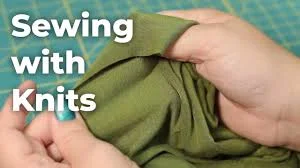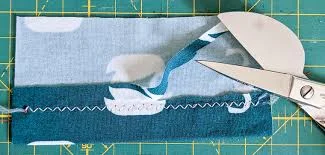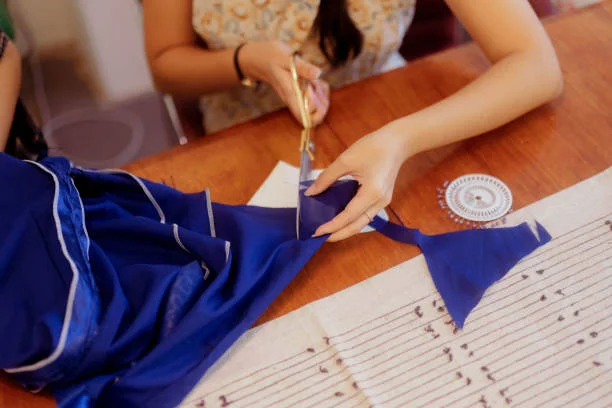Hemming jersey knit fabric is an important skill, especially when it comes to soft and stretchy jersey fabrics. How to Hem Jersey Knit Fabric?
This article will introduce you to several aspects, from material selection to sewing techniques, to help you sew the edges of jersey knit fabrics smoothly.
What is Jersey Knit Fabric?

Jersey knit fabric is a lightweight, soft and stretchy fabric usually made of cotton, polyester or a blend. Jersey knit fabric is a versatile and popular textile known for its unique properties.
It is made using a knitting technique that creates interlocking loops, which results in a smooth surface and a textured, slightly stretchy back. This construction gives jersey its unique drape and makes it comfortable and easy to wear.
Overall, Jersey knit fabric is popular for its comfort, variety of styles, ease of care (usually machine washable), durability (wrinkle-resistant), and affordability (available at a variety of price points), making it an essential part of many people’s wardrobes.
A List of Tools and Materials

Tools
- Sewing machine
- Tape ruler
- Sharp scissors
- Double needle (optional, for a stronger decorative effect)
Materials
- Jersey fabric
- Sewing thread (preferably to match the fabric color)
How to Hem Jersey Knit Fabric?

1. Preparing the Fabric
Proper preparation is crucial for achieving a clean hem on jersey knit fabric. Follow these steps:
1.1 Pre-washing and Drying:
- Wash the Fabric: Before cutting or hemming, wash the jersey knit fabric in cold water with a gentle detergent. This helps remove any sizing or chemicals from manufacturing.
- Dry the Fabric: Tumble dry on low or lay flat to dry. This pre-shrinking step ensures your finished garment won’t change size after hemming.
1.2 Measuring and Marking the Hemline:
- Determine Hem Length: Decide how much you want to hem. Common hem lengths for jersey knit garments range from 1/4 inch to 1 inch, depending on your design.
- Use a Measuring Tape: Measure from the bottom edge of the fabric and mark the desired hemline with fabric chalk or a fabric marking pen.
- Make a Straight Cut: If necessary, trim the fabric to create a clean edge, ensuring it remains straight and even.
2. Hemming Techniques
There are several effective methods for hemming jersey knit fabric, depending on your tools and skill level.
2.1 Sewing Machine Hem:
- Setup: Choose a stretch stitch on your sewing machine (often represented by a zigzag or lightning bolt icon) and select a ballpoint needle to prevent snagging.
- Position the Fabric: Fold the hem up to the marked line and pin it in place, ensuring the fabric lies flat without puckering.
- Sewing Process: Starting at one end of the hem, sew along the folded edge, keeping a consistent distance from the fold (usually 1/8 to 1/4 inch). Remove pins as you sew to avoid needle damage.
- Finishing Touch: After sewing, gently pull the hem to allow the stitches to relax. This helps maintain the stretch of the fabric.
2.2 Serger Hem:
- Setup: Thread your serger with appropriate thread for jersey knit. Ensure the machine is set for a 4-thread overlock stitch.
- Align the Hem: Fold the hem up and align the edge with the serger’s knife blade. Pin to secure.
- Sewing Process: Begin serging the hem by guiding the fabric through the machine. The serger will trim excess fabric while finishing the edge with a secure stitch.
- Adjusting the Hem: Trim any excess threads and ensure the hem lays flat. The serger method provides a clean, professional finish that stretches with the fabric.
2.3 Hand Hemming:
- Final Touches: Tie off the thread securely and trim any excess.
- Preparation: Use a double strand of thread for added strength, and select a needle suitable for jersey fabric.
- Folding the Hem: Fold the hem to the marked line and pin in place.
- Hemming Process: Start from the inside of the hem. Use a slip stitch or blind hem stitch, picking up small stitches on the main fabric while leaving the hem side free. This method is great for delicate or visible hems, allowing for flexibility and stretch.
3. Finishing Touches
Once you’ve completed the hemming, it’s time to finish up:
3.1 Pressing the Hem:
- Use a Pressing Cloth: Place a pressing cloth over the hem to protect the fabric while pressing. Use a low heat setting suitable for jersey knit to avoid damaging the fabric.
- Press Carefully: Gently press the hem to set the stitches without stretching the fabric. Avoid dragging the iron to prevent distortion.
3.2 Troubleshooting Common Issues:
- Puckering: If you notice puckering along the hem, it may be due to too tight stitching or stretching while sewing. Re-sew using a looser tension or try a longer stitch length.
- Skipped Stitches: If stitches are skipping, check that you’re using a ballpoint needle and the correct stitch setting. Adjust the tension as needed.
- Uneven Hem: For an uneven hem, remeasure and trim as needed, then re-sew, ensuring the fabric is flat and pinned securely.
With these detailed steps, you’ll be well-equipped to confidently hem jersey knit fabric. Each technique offers its unique advantages, so don’t hesitate to try different methods to find what works best for you. Happy sewing!
Some Tips and Tricks

When working with Jersey Knit Fabric, here are some tips and tricks to help you better deal with this material:
Choose the Right Presser Foot
To avoid the stretching of Jersey Knit Fabric, it is recommended to use a special presser foot. The shape of the presser foot should be rounded to avoid leaving marks on the fabric. Also, make sure to choose a presser foot suitable for knit fabrics.
Adjust the Thread Tension
Jersey Knit Fabric is very stretchy, so it is very important to adjust the thread tension. First, make sure that the thread is placed in the correct thread tension hole (usually the hole marked for knit). Then, you can gradually adjust the thread tension of the machine to find the best setting for the fabric. It is recommended to conduct several trials on scraps until you get a satisfactory result.
Use the Appropriate Stitch
Jersey Knit Fabric is best used with straight stitch or elastic stitch. The straight stitch can maintain the stretchability of the knit fabric, while the elastic stitch can provide additional elasticity when the knit fabric stretches.
Avoid Stretching
When sewing Jersey Knit Fabric, avoid overstretching the fabric to avoid causing distortion or deformation. You can gently relax the fabric to maintain its natural stretch.
Use a Double Needle Sewing Machine
If you often handle Jersey Knit Fabric, you can consider buying a double needle sewing machine. This allows two parallel elastic stitches to be sewn at the same time, providing a better decorative effect and increasing durability.
Take Time to Adjust
Each Jersey Knit Fabric may have different characteristics, so it is important to spend some time on sample testing and adjustment before officially sewing. This will help you understand the characteristics of the specific fabric such as stretch, stretch and thread tension, and choose the appropriate settings.
Use Appropriate Sewing Techniques
For Jersey Knit Fabric, there are some special sewing techniques that can improve the effect. For example, you can use double-sided transparent tape or knitted pockets to help stabilize the edge of the fabric when sewing.
Hopefully these experience tips will help you better handle Jersey Knit Fabric. Whether you are sewing clothes or home furnishings, mastering these techniques will enable you to deal with this special knit fabric more easily.
Summary
Sewing the edges of knitted fabrics requires some special skills and preparation. Whether you choose to sew by hand, use a sewing machine, or an ultrasonic shear, be careful to use the right materials and the right sewing method. With practice and experience, you will be able to sew knitted fabrics expertly and create comfortable and beautiful garments.
How to hem jersey fabric by hand? The above is a simple tutorial on how to hem Jersey knit. Hopefully these guidelines will help you!
Click on our website to get more information.
